Making homemade paneer is super easy! You’ll really be amazed at how little effort it takes, with a few minutes of hands-on time and a foolproof method. Keep reading, I’ll be sharing all the tips and tricks on how to make paneer at home perfectly soft every time.
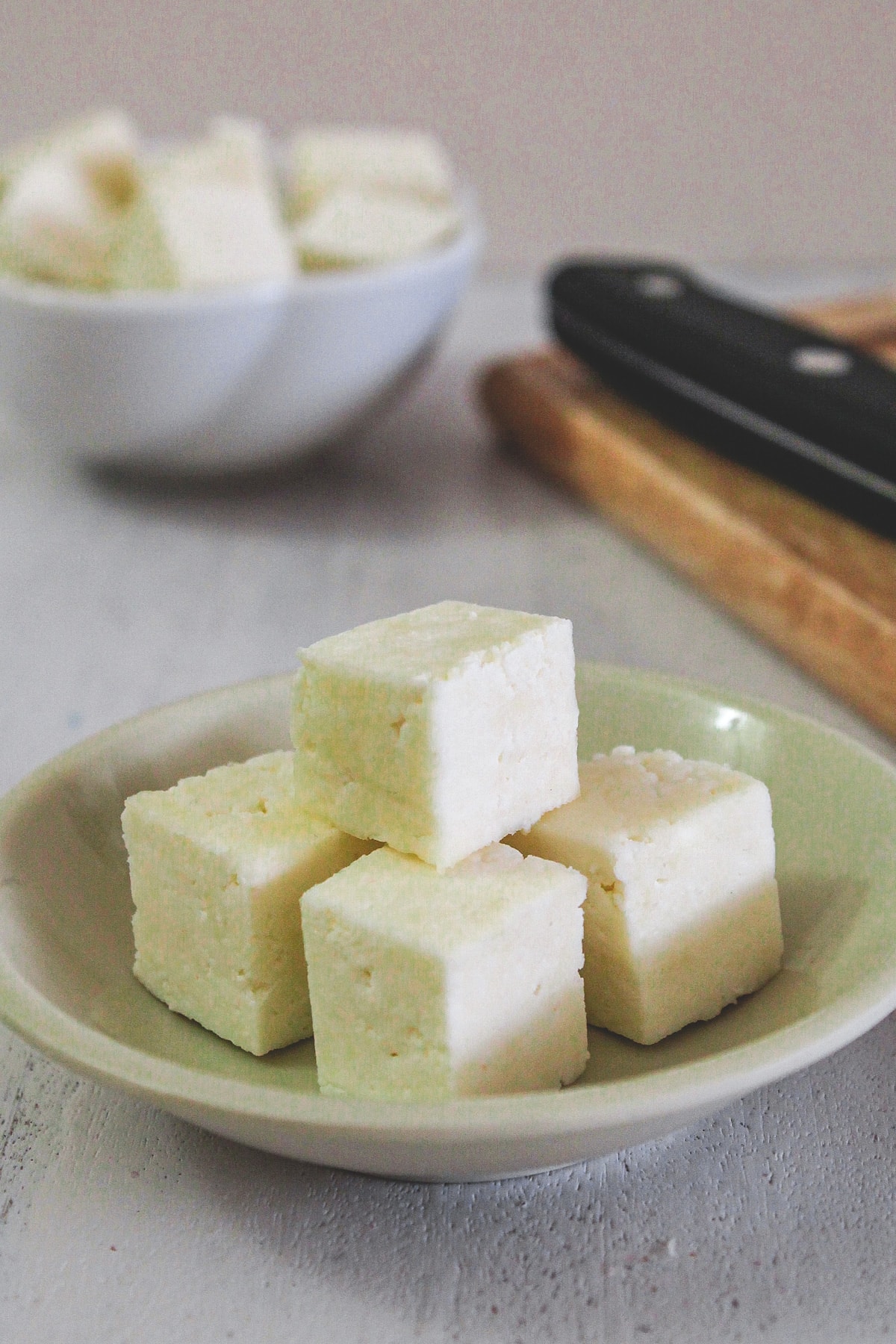
Jump to:
What Is Paneer?
Paneer is non-aged, non-melting, soft yet firm cheese made by curdling the milk using food acid like lemon juice, vinegar or curd (yogurt).
Paneer is also known as Indian cottage cheese. Though it is different from the cottage cheese that is available in containers at American grocery stores.
To make paneer, food acid is added to hot milk. So milk gets curdled and whey gets separated from milk solids. These milk solids are drained into a muslin cloth and then excess moisture is removed by pressing some weight on top. Then it is cut into paneer cubes.
🧾 Ingredient Notes For Homemade Paneer
Homemade paneer is made from just two ingredients - milk and the food acid of your choice. While sometimes store-bought paneer has some additives in it. So many prefer to make paneer at home. I am always short on time, so I make homemade paneer once in a while if I am in a mood.
Though homemade paneer is super soft, fresh, delicious and there is no comparison to store-bought paneer.
Milk:
- Always use full cream or full-fat whole milk to get the best homemade paneer. Also, use cow’s milk or Buffalo’s milk.
- Here I have used Cow milk as buffalo milk is not available in the USA. Cow milk has less fat content than Buffalo’s.
- So 1 litre of cow’s milk makes 150 grams of paneer while same from the buffalo’s milk makes 200-225 grams.
- Homogenized milk is most commonly available in stores. Since it is highly processed milk for better shelf life, it takes longer to get curdle compared to non-homogenized milk.
Food Acid: It can be any of the following - lemon juice, vinegar, yogurt.
- Lemon juice: I prefer to use lemon juice, as it gives a soft yet firm texture. Plus, I can rinse out the milk solids to get rid of any lemon juice flavor.
- Vinegar: It gives a firmer texture than made using lemon juice. It also curdles the milk faster. Sometimes it is hard to eliminate the vinegar smell from the paneer even after rinsing.
- Yogurt (Curd): It gives the softest texture compared to all three food acids. So if making paneer cubes, I avoid using yogurt. If making chenna for dessert then yes, yogurt is a good option.
👩🍳 How To Make Paneer? (With Photos)
1) Heat the milk in a heavy bottom pan or patila on medium heat.
2) As soon as it starts boiling turn off the stove. And let it stand for a minute.
3) Then add a teaspoon of lemon juice.
4) Stir the milk with a wooden spoon or spatula and the milk will starts to curdle. If it is not curdled completely then add a little more lemon juice at a time and stir. You have to stir as milk curdles otherwise it will stick to the bottom and sides of the pan.
5) Once it is curdled completely, you will see whitish or greenish whey and milk solids separated.
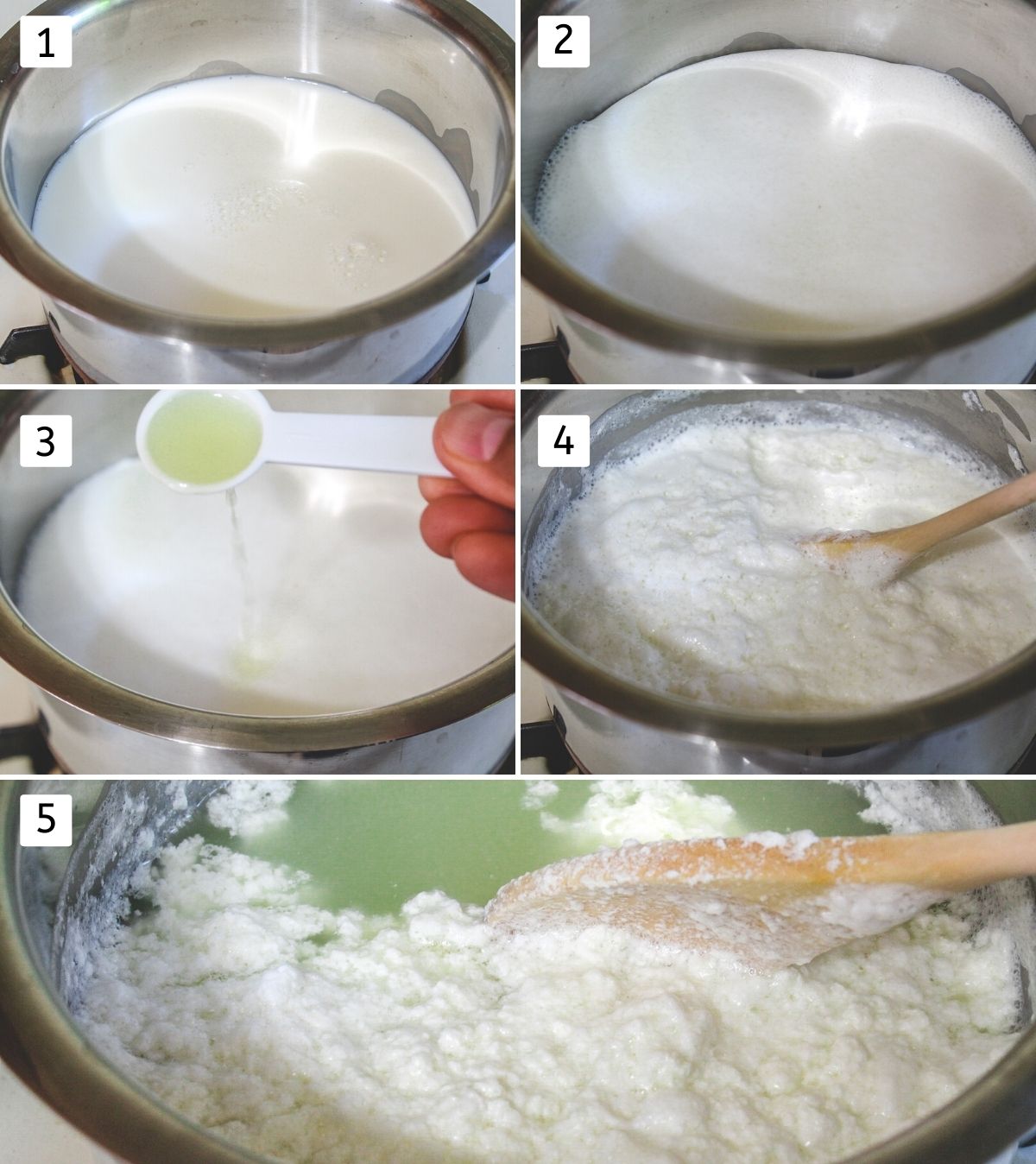
6) Put the muslin cloth or cheesecloth or man’s handkerchief on the strainer and keep the strainer on the bowl or jug to collect the whey. Strain curdled milk through the cloth to separate the milk solids and whey. Do not discard this nutritious whey, use the whey while making chapati dough, in soup as a stock or make cool beverages using whey.
7) Then wash the milk solids under running cold water, so all the sourness from the lemon juice will wash away. Also, as it cools down, it stops further cooking and prevents it from becoming chewy.
8) Now gather the edges of the cloth, tie and twist, and press lightly to remove all the moisture.
9) Place this on a plate (that has holes in it) and press, spread lightly.
10) Place another plate on top to get the flat top surface.
11) And then put some weight (books, rice or beans filled jar or heavy mortar pestle) on top. Let it set under the weight for 1 hour.
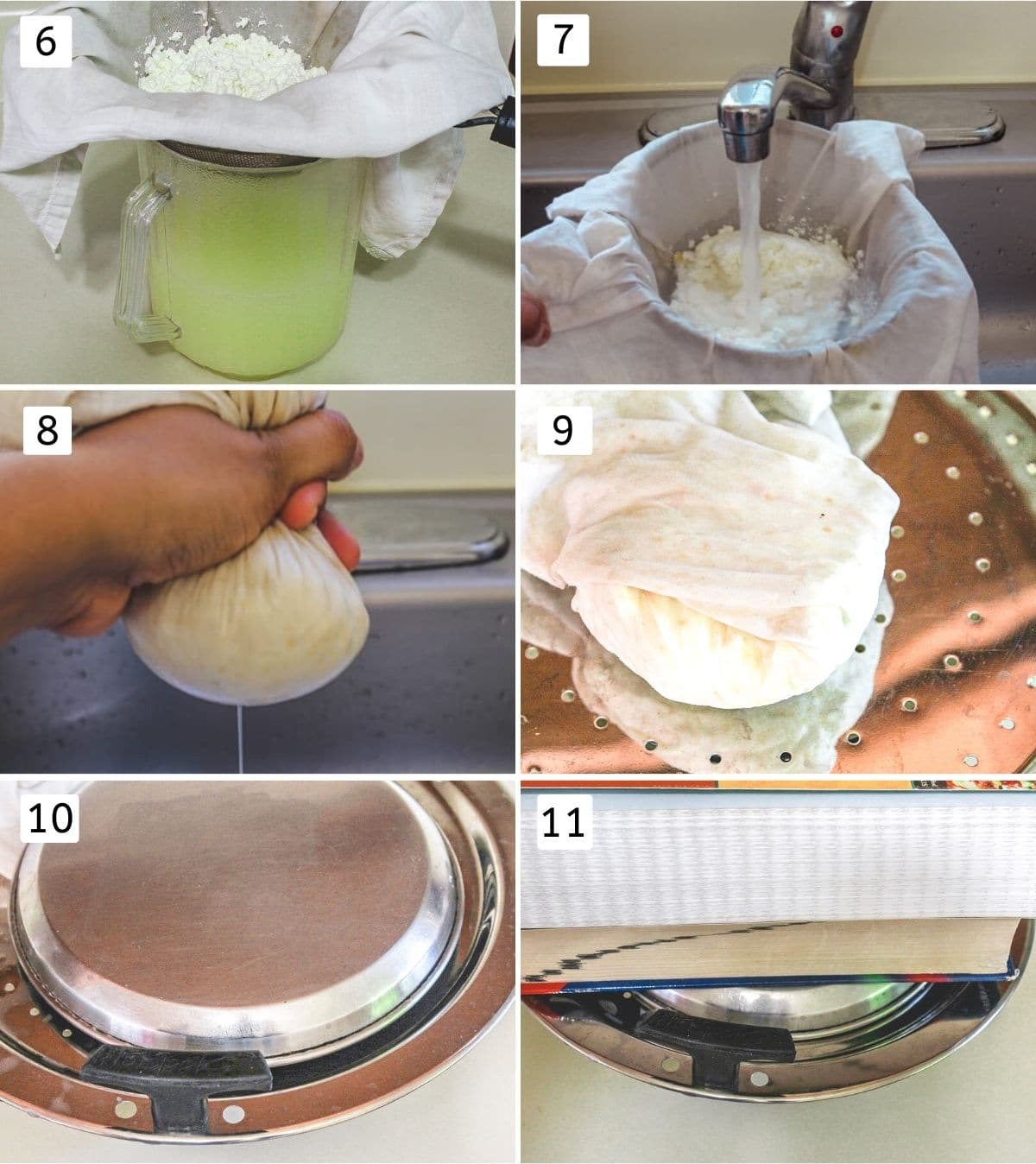
12) Now you have a block of paneer ready.
13) Slice them evenly.
14) And cut into paneer cubes.
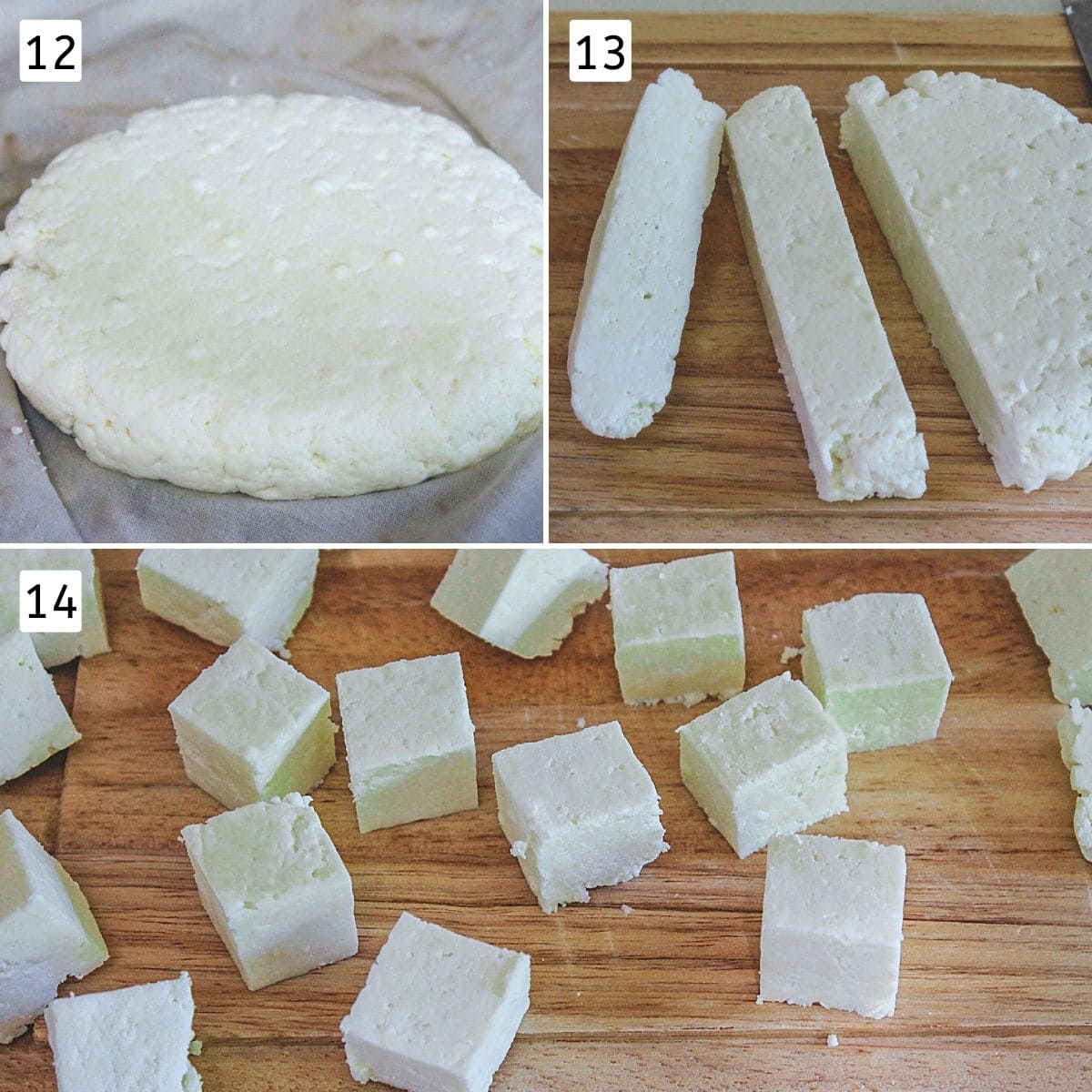
💭 Tips For Perfect Homemade Paneer
- Amount of food acid: Never use too much lemon juice or vinegar. Otherwise, paneer will have a slight flavor or smell. Plus, the paneer will turn chewy.
- How much food acid? There is no exact amount. Every brand or type of milk is different, so you’ll need a different amount of acidic ingredient. So always start with a little, stir and check. If not curdles, add a little more and check again. Be patient, homogenized and pasteurized milk takes time to curdle. So do not rush and add more lemon juice or vinegar.
- Once the milk comes to a boil, turn off the stove and then start curdling the milk.
- Once it curdles, drain it immediately. So keep cloth and strainer ready before you start making homemade paneer.
- Make sure that you’ve squeezed out the moisture before setting it using weight.
- Do not keep the weight for more than 1 hour otherwise, it will become drier.
🥣 Storage Instructions
- It stays good for 3-4 days in the refrigerator. Submerge the block of paneer or cubes in the water and keep it in the fridge. (Do change the water after every 24 hours) At the time of using, remove it from water, pat dry with a paper towel or kitchen napkin and use.
- If not kept in the water then it will dry out and becomes hard around the edges.
- What if you forgot to put it in the water. If so then right before using it, put it in warm water for 10 minutes to soften and moisten the dried edges.
- To freeze it, put it in a ziplock bag or airtight container and freeze it. It stays good for a month (actually I have not kept more than a month so not sure that it stays good over a month).
🍽 Use Of Homemade Paneer
- Paneer cubes are used in many savory dishes like paneer gravies (matar paneer, palak paneer, paneer butter masala, and so on), paneer pulao, paneer biryani, paneer tikka, paneer machurian, chilli paneer, etc.
- Don’t make paneer cubes and just crumble the fresh paneer and make paneer bhurji (dry version) or malai kofta or paneer paratha.
- The crumbled paneer is used in making Indian sweets like malai modak, paneer kheer, etc.
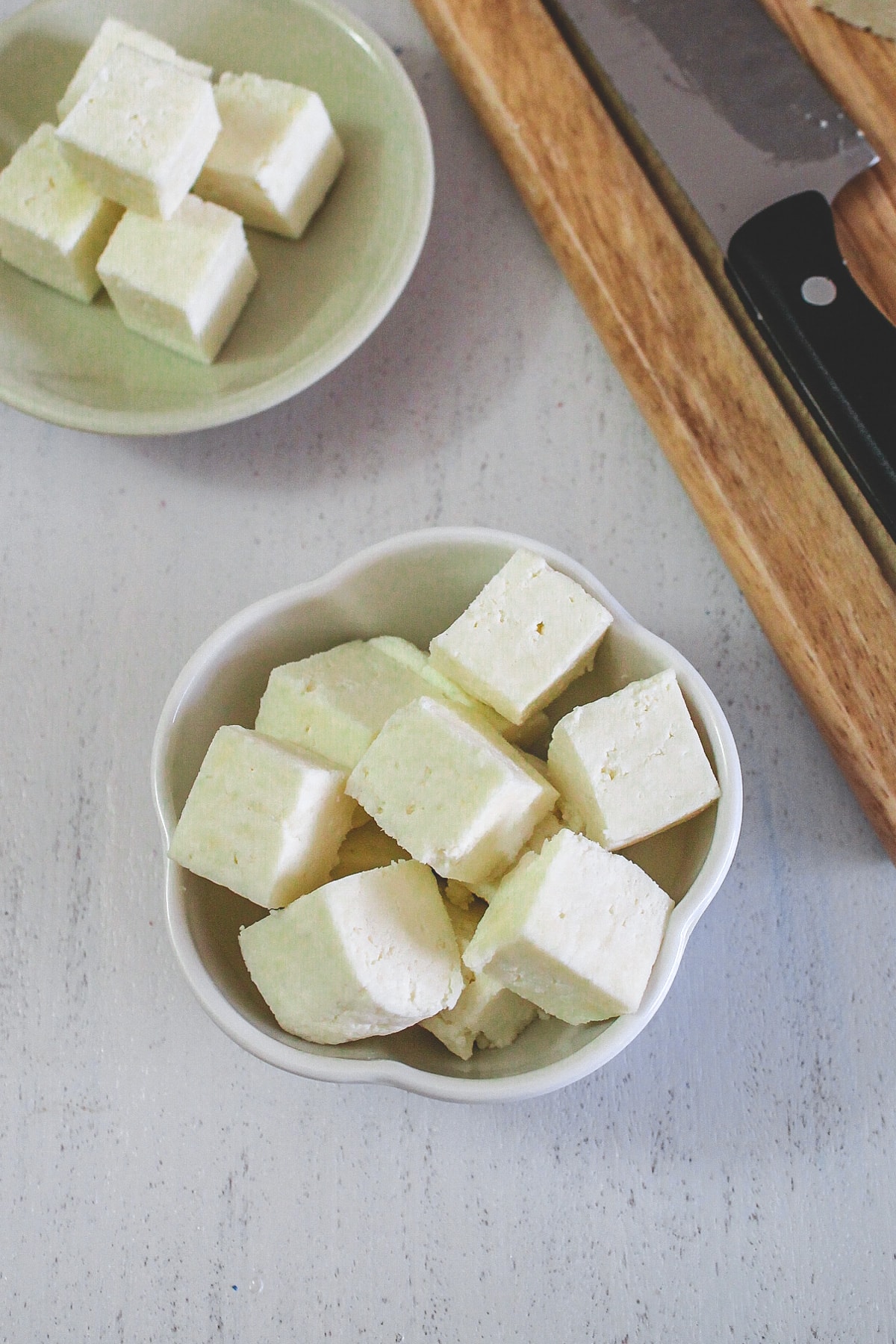
Hope you find this guide on how to make paneer at home helpful. If you have made it, I’d love to hear about it! Click here to leave a review.
Recipe Card
How To Make Paneer (Homemade Paneer)
Ingredients
- 4 ½ cups or about 1 litre milk (Full fat)
- 1-2 teaspoons Lemon juice
Instructions
- Heat the milk in a heavy bottom pan or patila on medium heat.
- As soon as it starts boiling turn off the stove. And let it stand for a minute.
- Then add a teaspoon of lemon juice. Stir the milk with a wooden spoon or spatula and the milk will starts to curdle. If it is not curdled completely then add a little more lemon juice at a time and stir. You have to stir as milk curdles otherwise it will stick to the bottom and sides of the pan.
- Once it is curdled completely, you will see whitish or greenish whey and milk solids separated.
- Put the muslin cloth or cheesecloth or man’s handkerchief on the strainer and keep the strainer on the bowl or jug to collect the whey. Strain curdled milk through the cloth to separate the milk solids and whey. Do not discard this nutritious whey, use the whey while making chapati dough, in soup as a stock or make cool beverages using whey.
- Then wash the milk solids under running cold water, so all the sourness from the lemon juice will wash away. Also, as it cools down, it stops further cooking and prevents it from becoming chewy.
- Now gather the edges of the cloth, tie and twist, and press lightly to remove all the moisture.
- Place this on a plate (that has holes in it) and press, spread lightly.
- Place another plate on top to get the flat top surface. And then put some weight (books, rice or beans filled jar or heavy mortar pestle) on top. Let it set under the weight for 1 hour.
- Now you have a block of paneer ready.
- Slice them evenly and cut into paneer cubes.
Notes
- Amount of food acid: Never use too much lemon juice or vinegar. Otherwise, paneer will have a slight flavor or smell. Plus, the paneer will turn chewy.
- How much food acid? There is no exact amount. Every brand or type of milk is different, so you’ll need a different amount of acidic ingredient. So always start with a little, stir and check. If not curdles, add a little more and check again. Be patient, homogenized and pasteurized milk takes time to curdle. So do not rush and add more lemon juice or vinegar.
- Once the milk comes to a boil, turn off the stove and then start curdling the milk.
- Once it curdles, drain it immediately. So keep cloth and strainer ready before you start making homemade paneer.
- Make sure that you’ve squeezed out the moisture before setting it using weight.
- Do not keep the weight for more than 1 hour otherwise, it will become drier.

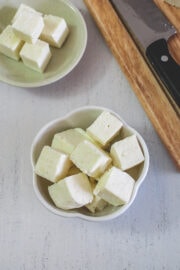
Nikita
Hi, any suggestions on which brand of milk to use for this in the USA? Im not sure which brands would yield this much paneer
Kanan Patel
Any brand of full-fat whole milk in the USA gives approx 150 grams paneer. I mostly use Kirkland (Costco) brand.